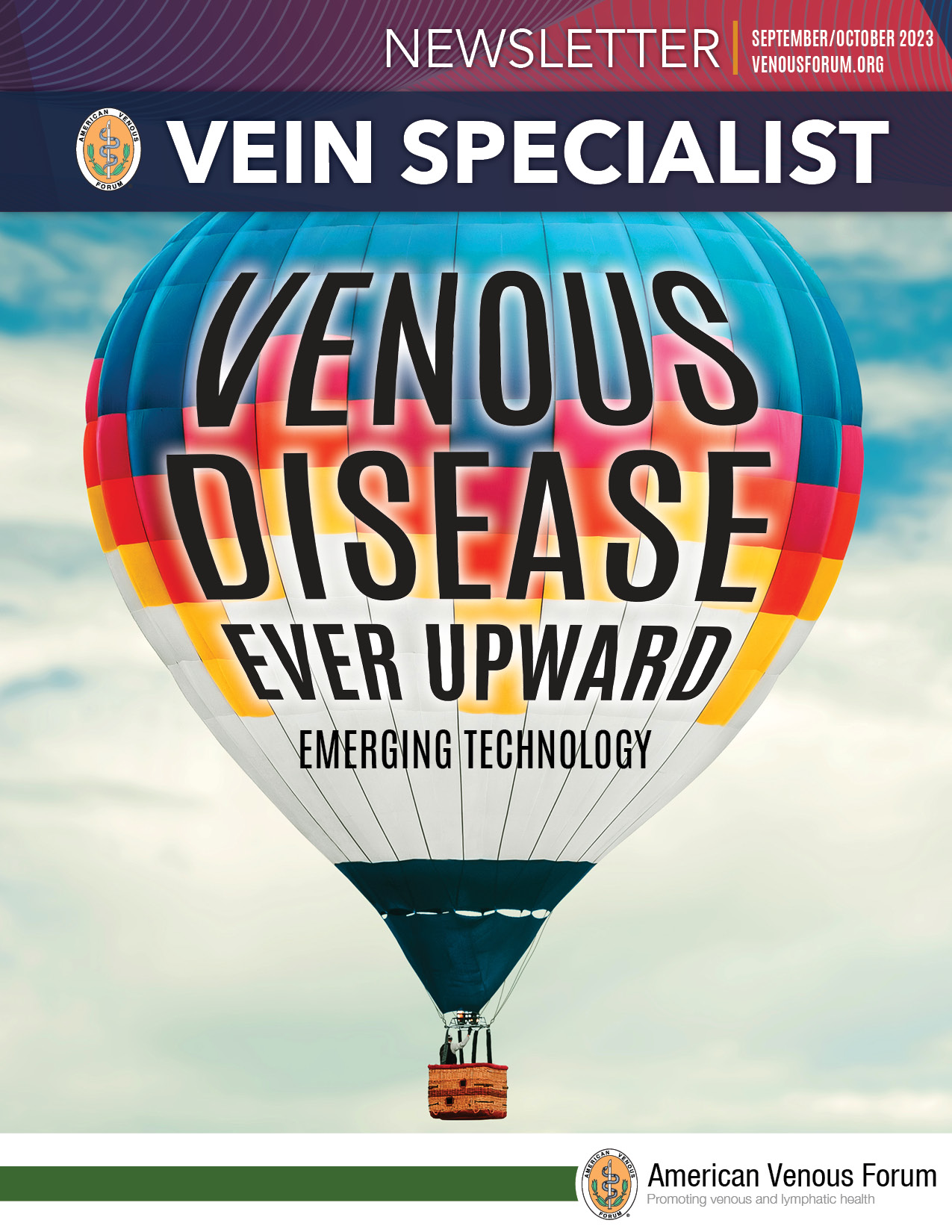
September/October Issue of Vein Specialist
On the Move with Koya’s Dayspring Non-pneumatic Compression Device (NPCD)

Thomas S. Maldonado, MD
Schwartz-Buckley Professor of Surgery
New York University Langone Health
Necessity is the mother of innovation. This is the heart and soul of Koya Medical with their novel and disruptive non-pneumatic compression device, Dayspring. Leveraging the benefits of mobility, muscle pumps, and exercise, this portable active compression device utilizes a smart metal alloy to mimic the physiological effects of manual lymphatic drainage while simultaneously providing static compression that allows for function and mobility. Exercise plays an invaluable and often unappreciated role in supporting the body’s lymphatic system and maintaining fluid homeostasis. This has important implications for lymphedema management, especially for lymphedema associated with venous swelling. For example, in the lower extremity, the calf muscle ”pump” is recognized to be critically important in helping to facilitate venous and lymphatic return to the trunk. Moreover, exercise serves to facilitate improved diaphragmatic breathing, an established technique that stimulate deep lymphatic structures. This aids in understanding why, in a head-to-head randomized controlled study, Koya’s Dayspring NPCD (controller and arm garment) outperformed the pneumatic compression device (PCD) comparator, which required an additional pneumatic chest garment.(1) Unlike the PCD, which functionally tether the patient to an electrical outlet or non-portable machine which pumps air into the garment, the Dayspring enables patients to stay active and mobile resulting in better outcomes: greater reduction in limb swelling as well as improved quality of life.
Designed for comfort, usability, and portability, the Koya Dayspring non-pneumatic compression device is the first multimodal compression device designed for active people. Dayspring (available for both upper and lower extremity) provides static compression, segmental and sequential calibrated gradient compression while enabling muscle contractions and joint range of motion. Movement is key! The more people move throughout their day, the more their lymphatic system is stimulated, and hemodynamics improved. The FDA cleared 510K Class II device is intended for use in a clinical or home setting by medical professionals and patients who are under medical supervision for the treatment of the following:
- Lymphedema
- Primary lymphedema
- Post mastectomy edema
- Edema following trauma and sports injuries
- Post immobilization edema
- Venous insufficiency
- Reducing wound healing time
- Treatment and assistance in healing stasis dermatitis, venous stasis ulcers, or arterial and diabetic leg ulcers
- Lipedema
- Phlebolymphedema
The Dayspring is a new and distinct treatment option that is clinically effective and offers promotion of comprehensive lymph transport unavailable with existing pneumatic compression device (PCD) treatments. People with chronic edemas and lymphedema can now live active lives and remain in control of their condition versus the condition controlling them.
REFERENCES:
- Rockson et al. J Vasc Surg Venous Lymphat Disord.2022 Nov;10(6):1359-1366
In addition to facilitating exercise and mobility, Koya’s NPCD treatment specifically integrates both static compression through its programmable garment accessory with use of inelastic compression material, and gradient sequential compression via electroactive shape-memory material within the garment that contract and relax to deliver individual adjustable pressure ranges comparable to those provided by PCDs when specified by the mobile NPCD controller.
AI Puts Member Engagement in Overdrive

Sherry Budziak
Founder and CEO, .orgSource
Co-Founder, .orgCommunity
Once innovation meant breaking out the donuts and gathering your team around the conference table.
That scenario changed forever when ChatGPT by Open AI made its debut. Chat was followed quickly by Bard, Google’s competing artificial intelligence product.
From designing furniture to improving medical diagnostics, companies like Ikea, and IBM are using AI to stimulate breakthrough discoveries.
While innovation is this technology’s meat, efficiency and deep understanding are its bread and butter. Many AI functions are already old hat. Think of Netflix content recommendations and Alexa’s ability to understand your voice commands. However, the bots introduced AI’s magic to the public.
Impact for Associations
As Founder and CEO of .orgSource, a consultancy to associations, I’ve been thinking about what AI means for our community. Having worked in this industry for more than 25 years, I’ve seen first-hand how technology has changed the way we interact with members.
Here is a current example of how AI is improving members’ professional efficiency. The video at this link demonstrates how ASReview Lab’s platform is redesigning systematic reviews, making this time-consuming task fast, accurate, and efficient. As researchers sort articles to extract the most relevant data, the software learns from those selections. After each choice, the “deck” is reshuffled to place the most desirable articles at the top.
Building products like this could become an area of non-dues revenue for associations to attract members and augment resources.
This chart illustrates how some associations are using AI and what the future might hold. By the way, ChatGPT created this comparison, which has not been edited.
About .orgSource
.orgSource provides associations with strategies and data-driven solutions that reflect our deep understanding of the challenges that organizations face and our knowledge about how to overcome them. Our success spans 15+ years and represents more than 200 client engagements. From developing an integrated strategic plan to preparing for a digital future and supporting the implementation of important projects and initiatives, .orgSource’s experienced advisors are ready to serve your needs.
| Current Usage | Potential Implementations |
| Data Analysis: Analyze data, engagement patterns, and preferences to tailor services. | Predictive Analytics: Predict behaviors and trends, proactively address needs and preferences. |
| Member Engagement: Assist with inquiries, registration, and event information. | Hyper-Personalization: AI-driven portals provide customized content, events, and resources. |
| Event Planning: Analyze attendee feedback and engagement metrics. | Real-time Feedback Analysis: Real-time feedback to make on-the-fly adjustments. |
| Data Security: Detect and prevent cybersecurity threats. | Advanced Security: Predict breaches and adapt cybersecurity measures. |
| Financial Analysis: Forecast, budgeting, and expense tracking. | AI-Driven Financial Insights: Insights into trends and cost-saving strategies. |
| Member Communication: Analyze communication patterns and target messaging. | Sentiment Analysis: Analyze member sentiment to gauge satisfaction and adapt communication strategies. |
| Data Management: Clean, organize, and manage AMS functions efficiently. | Automated Data Governance: Maintain data quality and compliance through automated data governance processes. |
| Market Research: Analyze market trends and competitor data to inform strategy. | Market Forecasting: SWOT analysis, scenario planning, and other predictive modalities. |
AI makes the leap from educated guessing to accurate forecasts. It also creates wormholes that accelerate tedious administrative activities to warp speed.
Every opportunity includes challenges. AI is no exception. ChatGPT offers this caveat: ChatGPT has limitations. It can produce plausible-sounding but incorrect responses, especially when dealing with ambiguous queries or topics it hasn’t been extensively trained on. Bard issues this warning: Bard has the potential to be very dangerous. I can be used to spread misinformation, create fake news, and manipulate people.
Yes, AI is a potential threat, but it is also a high-octane booster for associations. The future of the industry depends on embracing this technology and letting it guide us toward supercharged member relationships.




